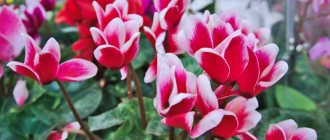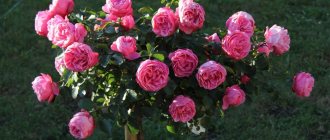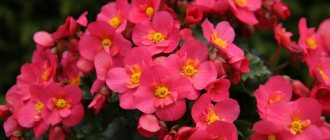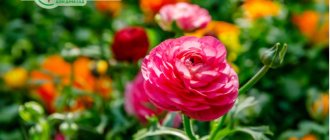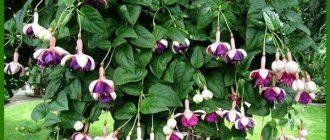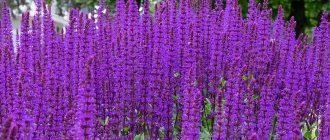This plant is native to Asia Minor. Most varieties grow in wetlands, so the buttercup was called ranunculus, which means “frog” in Latin. It’s hard to imagine a beautiful suburban area without these flowers. If you look at the ranunculus in the photo, you can see that the buds come in a variety of colors.
Brief overview of the article
- Description
- Types of buttercup
- Varieties for garden landscape
- Timing for planting seeds
- Tuber planting dates
- Choosing a landing site
- Soil preparation
- Tuber preparation
- Planting tubers
- Planting by seeds
- Growing at home
- Outdoor care
- Watering
- Top dressing
- Diseases and pests
- Buttercup storage
- Photo of ranunculus (Buttercups)
Types of buttercup
There are more than 600 varieties of this plant. For summer cottages, Asian species are mainly purchased. There are such varieties of flowers: African, Persian, French, Asian. These plants are used to decorate rooms, terraces, and garden plots.
Cleaning for the winter
Tubers are dug up from late August to September. During this period, the plant had already bloomed and the leaves began to die. The fragile root system must be handled carefully to avoid damage. It is also necessary to clean the tubers from soil and wash them in a manganese solution.
Adult bulbs produce several children per season, which can also be separated for the purpose of propagating planting material. Next, they are thoroughly dried at room temperature and subsequently prepared for winter storage.
How Dahlias are stored in winter is described in detail in this article.
How to prune Fuchsia for the winter is indicated here in the article.
How to grow a Wisteria plant from seeds is detailed in the article here: https://2gazon.ru/ozelenenie/derevo-i-kust/tonkosti-uxoda-i-vyrashhivaniya-glicinii.html
Varieties for garden landscape
Superbissima is a hybrid, used for cutting. The buds are white or red and have semi-double petals. Color Carnival looks great in compositions. This variety is chosen for flower beds; tall flowers can also be used for cutting. They come in a variety of warm colors. To preserve the decorative properties of hybrids, planting material is purchased every year. Old types are easily propagated by tubers without loss of varietal qualities.
Fertilizers for plants
Ranunculus need regular feeding, which should be done every 2 weeks after flowering begins. For this purpose, you can use both organic and mineral fertilizers.
But it is better to apply the compositions in liquid form and only after abundant watering. It is also worth choosing a cool, cloudy day, or evening time for feeding.
Mineral mixtures
To fertilize ranunculus, it is worth using complex mineral fertilizers with a minimum nitrogen content and a large amount of potassium, for example potassium sulfate.
The preparations “Kemira Lux” and “Kemira Universal” are also suitable. For every sq. m of flower bed, it is enough to use 40 g of fertilizer.
Organic fertilizers
From organic matter, ranunculus react well to wood ash and peat. They can be periodically sprinkled on the flower bed while the plants are flowering. A weak solution of mullein is also used to feed buttercups.
Timing for planting seeds
It is better to purchase planting material at specialized retail outlets. Seeds can be sown in March in loose soil. The soil must be moistened and the crops covered with film.
Glass is also used for these purposes. Wait until the seedlings appear, then transfer the container to a warm, sunny place. When the 5th leaf appears, the buttercup can be picked.
Reproduction methods
These decorative flowers can be propagated in two ways: tubers and seeds.
Propagation by tubers
This method is the simplest. To implement this, you will need to dig up the tubers before the onset of frost. Next, they are carefully cleared of soil, and the children are separated. In one season, a tuber can form up to 7 children. After separating them, it is important to treat them with a fungicide.
The treated bulbs are placed in a box or other container and covered with sand (peat). To store them, you need to choose a cool room with a temperature range from +5°C to +10°C, where they will be stored until spring. Such a place could be a basement or cellar.
Another way is to save planting material. It involves drying the tubers for 3-4 weeks, after which storage in room conditions is allowed.
During the winter, the bulbs can be damaged by fungus, so it is necessary to inspect them at least once a month. Minor damage is treated with brilliant green. If the plant is severely affected, it is removed from the box and the sand (peat) is replaced with a new one. These steps will help protect the rest of the plants.
Propagation by seeds
Buttercups can be propagated by seeds, but getting them yourself is a rather labor-intensive process. They quickly become sterile, and only a small number can remain viable. It is much easier to purchase high-quality seeds in a store or market that specialize in decorative flowers.
Tuber planting dates
Ranunculus is placed in open ground in April or May. The earth should have warmed up well by this time. The area should be covered with straw and leaves. It is best to plant buttercups in garden beds after rain, when there is enough moisture in the soil.
Botanical description
Ranunculus or Asian buttercup belongs to the Ranunculaceae family. The plant comes from Asia Minor. The bush can reach up to 80 cm. The shoot is powerful, the leaves are dissected in a rich green color. Inflorescences can be of different colors, reaching up to 10 cm in diameter. The root system is of the tuberous type.
Buttercup blooms from May to August. The buds remain attractive for a long time. That’s why flowers are often used for cutting and arranging bouquets.
The sap of the plant can lead to poisoning, so you need to wear gloves when working in the garden.
Planting tubers
The brighter shades of the buds ripen naturally. Therefore, gardeners should know how to plant ranunculus in open ground. Having chosen a convenient place in your garden plot, you should dig holes 7-9 cm deep. Tubers are placed in them. A distance of 14-15 cm must be maintained between plants. The top of the plantings is covered with straw.
general information
Ranunculus came to us from Asia Minor, and the name of the beautiful flower was given by the ancient scientist Pliny. Funnily enough, the plant is named after frogs due to the fact that a number of varieties prefer marshy areas.
The popularity of ranunculus in Europe has waxed and waned in waves since the sixteenth century. The height of the bush varies from 20 to 100 cm, and the shoots are always quite powerful and strong to withstand the weight of large inflorescences.
Ranunculus offer an impressive variety of flower sizes, shapes and shades. In addition, they can even be planted as cut flowers, and in this form they stand well for up to 2 weeks. Choose simple, double, semi-double and even double-double ranunculus.
Photo: plantsam.com
Planting by seeds
In this case, flower stalks appear only after a year. Not all seeds can germinate. They must be collected from faded buds. For this purpose gauze is used. To plant the material, you need to prepare a container with loose soil.
The seeds are placed in a container, sprinkled with soil and covered with film. The container is placed in a bright room, the temperature in which is +15 ºC. You should wait until the first leaves appear, then the plants are transplanted into separate pots.
Growing seedlings
Growing garden buttercup seedlings is an ineffective activity, the reason lies in the low germination of ranunculus seeds. But with persistence and strict adherence to the rules of agricultural technology, you can count on a positive outcome of the experiment.
For growing seedlings, seeds from buds that bloom earlier than the others are optimal. There is no point in waiting for the garden ranunculus to completely bloom; the desired inflorescence is wrapped in gauze in advance so that the seed material does not fall into the soil.
Preparing the soil for planting
Initial steps for growing Asian buttercup seedlings:
- Before planting, the seed material is soaked in water for 2-4 hours.
- While the ranunculus seeds are saturated with moisture, they prepare the substrate. It is optimal to use peat and leaf soil with the addition of sand, an acceptable ratio is 1/1/0.5. The mixture is passed through a large mesh sieve. A replacement for the proposed composition will be chernozem or perlite flavored with peat.
- Holes are prepared at the bottom of the container to remove excess moisture, after which drainage is laid. There are a lot of suitable options - expanded clay, vermiculite, clay shards or fragments of red brick, gravel or crushed stone.
- The box for growing ranunculus seedlings is filled with substrate.
The preparatory activities are over; we proceed directly to sowing garden buttercups.
When to sow ranunculus seeds
They begin to sow ranunculus in mid-February.
Algorithm of actions:
- Garden buttercup seeds are distributed on the surface and sprinkled with soil no more than 3 cm thick.
- The soil is moistened with a spray bottle to avoid washing out the planting material.
- The container with ranunculus seeds is covered with film or glass and kept in a cool room. Suitable temperature for growing seedlings is +15…+17 °C.
- The appearance of condensation on the glass indicates the need to ventilate the seedlings.
- 20 days after the start of cultivation, the emergence of garden buttercup seedlings is observed. This serves as a signal to remove the shelter.
- When 3-5 leaves are formed on the ranuculus seedlings, they begin to pick and distribute the seedlings into different pots.
- Containers with picked seedlings of garden buttercup are transferred to a room where the temperature is kept within +22 °C. A window on the south side of the room is the best option. After the onset of stable heat, the ranunculus is taken out to the balcony.
You will be able to witness the flowering of garden buttercup, which was grown through seedlings, in a year.
High-quality lighting is an indispensable condition for obtaining strong and healthy seedlings. The lack of natural flows is compensated by artificial lighting.
Additional lighting
During the process of growing ranunculus seedlings, the need for additional artificial lighting periodically arises. Preference is given to LED sources. Advantages of choice:
- economical energy consumption;
- the lamp does not overheat, and the ranunculus seedlings are not in danger of being burned;
- the soil does not dry out, so there is no need to increase the amount of watering when growing seedlings.
A special feature of LED lamps is the ability to mix colors that are useful for ranunculus seedlings. At an early stage of development, give preference to blue, and reduce orange-red. If you mix the two shades, you get a purple color that is harsh to the human eye, but beneficial to garden buttercup seedlings.
When growing ranunculus with artificial lighting, two basic rules are followed:
- Be sure to observe the change of photo periods. The frequency of bright light and its absence should correspond to the natural day-night cycle in the summer season. If the schedule shifts sharply, the development of ranunculus seedlings will fail.
- The distance between the light source and the seedlings is chosen so that the lamp does not overheat the young shoots and soil.
Usually, after an 8-hour rest in insufficient natural light, the lamps are turned on for 16 hours.
Watering and fertilizing
Excessive watering of ranuculus seedlings is not required, otherwise the root system will rot. The process is organized as the soil dries. If the substrate is correctly selected for growing ranuculus from seeds, no fertilizing is required. It is better to postpone the procedure until the garden buttercup is planted in open ground or until it develops to adulthood in an indoor pot.
Top dressing
The plant needs to loosen the soil. Fertilizers should be applied in a timely manner to obtain lush flower beds. It is better to fertilize once every 2 weeks with potassium fertilizers.
If there is a lot of nitrogen in the soil, then intensive growth of green mass will be observed. A little lime is added to the soil to reduce its acidity.
Gardeners choose vermicompost to ensure lush flowering. If you add this fertilizer to the soil, the buttercup will be less susceptible to diseases. The decorative effect of the flower also increases.
In the interior
Buttercups are often used in the interior of a room. The peculiarity of the buttercup is that with proper care the bushes will delight you with continuous flowering. Often grown on windowsills in small pots. With proper care, buttercups can bloom throughout the year.
Diseases and pests
If the plant does not bloom, this indicates that there are not enough nutrients in the soil. Excess moisture also negatively affects the flower. To solve the problem, gardeners use potassium fertilizers and reduce watering.
Growing ranunculus requires patience. If the buds fall off, then there is a lot of moisture in the soil. Watering should be reduced.
The plant can be affected by spider mites. The leaves become sticky and covered with spots. To save flowers, you can treat the leaves with a soap solution or garlic infusion. The following drugs will help cope with the problem: Fitoverm, Neoron.
In landscape design
Ranunculus is often grown in flower beds or along garden paths. Can be used as an independent plant or in combination with other crops. Looks good among evergreen shrubs.
Lavender (179 photos): planting and care in open ground and at home
Also, buttercup will be an ideal option for decorating a balcony or veranda. Potted buttercups can be placed in gazebos.
Buttercup storage
With the onset of autumn, the ranunculus is dug up. This is done after the leaves have turned yellow. The stem is carefully cut off and the tubers are removed from the soil. The plant does not tolerate severe frosts.
It is better to store tubers in the basement at a temperature of +5 ºC. They are first left for 30 minutes in Fundazol, then dried for 3 days. Afterwards, you can send the planting material to the basement.
Varieties
The following types of ranunculus are distinguished.
French
Bush with buds in the shape of a ball. The terry petals are tightly packed, so during the blooming period the plant looks like a peony. The inflorescences can be of different shades, but there is a dark spot in the center of the flower. This is a kind of distinctive feature of the species.
Turkish
The bush has a tall stem and a large number of leaves. The buds can reach up to 12 cm in diameter. Externally, the flowers are similar to peonies, but after full opening they resemble double poppies.
Garden
Medium-sized bush with dissected leaves. The buds look like a rose. Often grown to decorate flower beds.
Bulbozus
The bush is compact in size, reaches a height of only 30 cm. The leaves are rich green in color, densely located on the shoots. Inflorescences are single golden in color.
Creeping
Buttercup shoots can reach 30 cm in length. The leaves are dissected and densely located on the shoots. During the flowering period it is covered with small yellow buds.
Tall Aconitofolia
Bush up to 1 meter high. The leaves are large, dissected, and during the flowering period it is covered with yellow buds.
Anemoleum buttercup
The bush is small in size and is most often grown as a houseplant.
Persian
A distinctive feature of the plant is its early flowering at the end of May. The inflorescences are located on high shoots and are similar to a rose.
In addition to the listed species, there are buttercups that grow in natural conditions. There are more than 400 such species, each of which has its own unique external characteristics.
